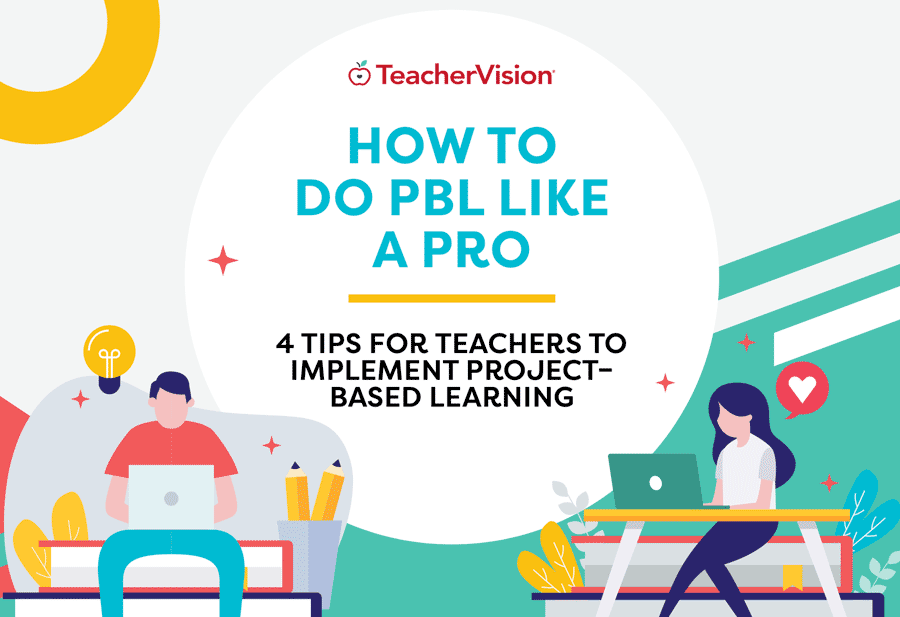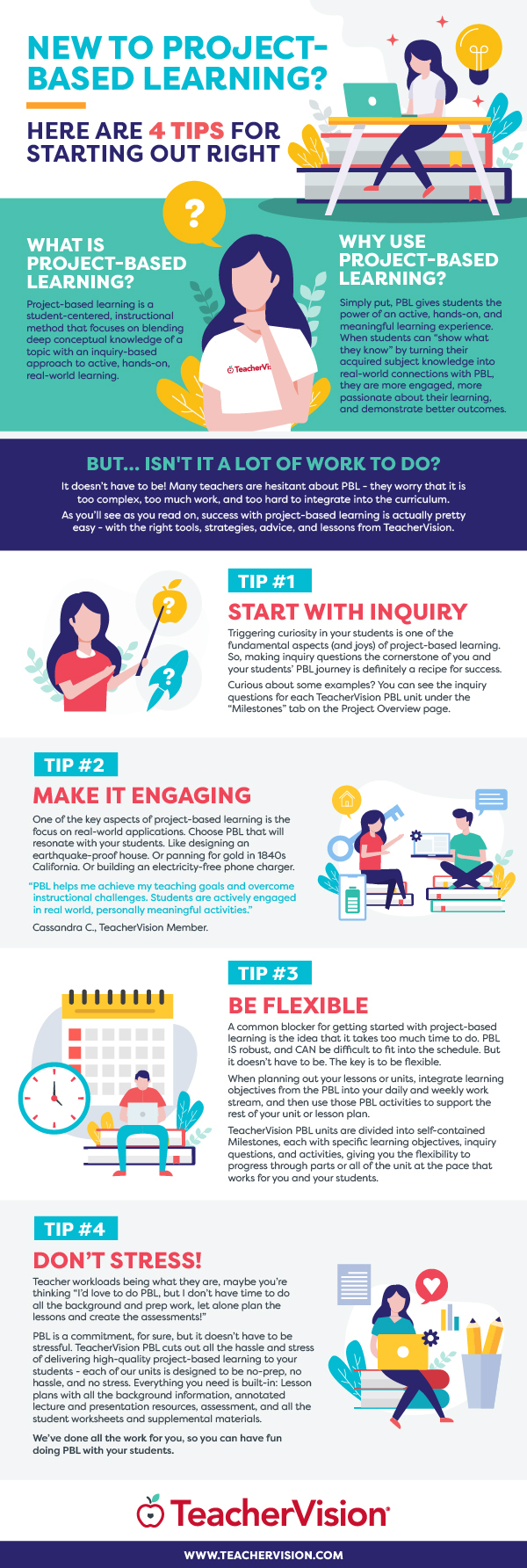Whether you’ve never tried project-based learning before, are transitioning from teaching with simple projects to using deep, inquiry-based learning, or want to spread your wings after experimenting a little bit, we’ve plucked the best gems from our team of PBL users and advisors to help you start out right!

What is Project-Based Learning?
Project-based learning (PBL) is a student-centered, instructional method that focuses on blending deep conceptual knowledge of a topic with an inquiry-based approach to active, hands-on, real-world learning. The central element in project-based learning is a meaningful, pedagogically-rich, in-depth project that challenges learners to build both academic subject knowledge and foundational skills like critical thinking, creativity, collaboration, and problem-solving.
Project-based learning lesson plans, rubrics, and ideas generally provide teachers with an extended framework of inquiry-based learning activities that can be modified or adapted for a variety of learning styles, time periods, real-world problems, and topics, normally including a strong curriculum focus enhanced by an engaging multi-stage hands-on project.
"Blending deep conceptual knowledge of a topic with an inquiry-based approach to active, hands-on, real-world learning."
Why Use Project-Based Learning?
Simply put, PBL gives students the power of active, hands-on, and meaningful learning experiences. When students can “show what they know” by turning their acquired subject knowledge into real-world connections with PBL, they are more engaged, more passionate about their learning, and demonstrate better outcomes.
“PBL lets me achieve my goals of [fostering] student creativity and student agency. And it gives my students independence and choice. They are creative and excited and working together.”
Molly H., TeacherVision Member
But…Isn’t It Hard [A Lot of Work] to Do?
It doesn’t have to be! Many teachers are hesitant about implementing project-based learning - they worry that it is too complex, too much work, and too hard to integrate into the curriculum. They wonder if it is too rigorous for their students, if it can be differentiated, if it requires a lot of background knowledge, or if it will take up too much time. These are all very good questions.
As you’ll see as you read on, though, success with project-based learning is actually pretty easy - with the right tools, strategies, advice, and lessons from TeacherVision.
Tip #1: Start with Inquiry
Triggering curiosity in your students, the kind that drives a burning desire to answer the “What the heck??!!” questions, is one of the fundamental aspects (and joys) of project-based learning. So, making inquiry questions the cornerstone of student learning using PBL is definitely a recipe for success.
Research indicates that inquiry-based learning produces better results and outcomes for students. It drives high engagement, development of social-emotional skills, and better connections between concepts and real-world applications. It’s also a lot of fun, and especially infectious if you model your own curiosity and let students “teach” you what they learn while answering their burning questions.
Curious about some examples of Inquiry? Each TeacherVision PBL unit will list inquiry questions on the project overview page under ‘Milestones’ - scroll down the page to find them.
Tip #2: Make it Engaging
One of the key aspects of project-based learning is the focus on real-world applications and building 21st-century skills. Meaningful, multi-stage, hands-on projects that help students translate what they learn in class into “aha!” moments about how things work in the world outside will both broaden and deepen what they already know. Beyond that, the chance to be independently creative, think critically, solve problems, and make cool stuff will hold their attention and help them retain key topics and concepts (while also making cool stuff!).
In all likelihood, your students are used to, and like, doing simple projects. With multi-stage PBL units, you can give them an opportunity for immersion in a deeper, richer, and more interesting learning process with tangible learning goals.
So make it engaging. Choose PBL that will resonate with your students. Such as designing an earthquake-proof house. Or panning for gold in 1840s California. Or building an electricity-free phone charger.
“PBL helps me achieve my teaching goals and overcome instructional challenges. Students are actively engaged in real world, personally meaningful activities.”
Cassandra C., TeacherVision Member.
Related article: 5 Pitfalls of Project-Based Learning (and How to Avoid Them)
Tip #3: Be Flexible
A common blocker for getting started with project-based learning is the idea that it takes too much time to do. The misconception is usually that because it’s so robust, and features so many moving parts, it’s very difficult to fit into an already-crowded curriculum calendar.
PBL IS robust and CAN be difficult to fit into the schedule. But it doesn’t have to be. The key is to be flexible with student work. For starters, you don’t have to follow the script down to the letter, and you don’t have to start at the beginning and work your way all the way through to the end. You can do PBL in parallel with your units and lessons. When planning out your lessons or units, integrate learning objectives from the PBL into your daily and weekly work stream, and then use those PBL activities to support the rest of your unit or lesson plan.
If you do decide to start at the beginning and take students all the way through a PBL unit, do it at a pace that works for you and them. If you’ve got the time at the end of the year to spend an entire week on PBL, go for it! If you need to break it into chunks over a month during a busy part of the year, you can do that, too. There’s no right way or wrong way to do it.
TeacherVision PBL units are divided into self-contained Milestones, each with specific learning objectives, inquiry questions, and activities, giving you the flexibility to progress through parts or all of the unit at the pace that works for you and your students.
Tip #4: Don’t Stress!
Teacher workloads being what they are, maybe you’re thinking “I’d love to do PBL, but I don’t have time to do all the background and prep work, let alone plan the lessons and create the assessments!”
That’s totally understandable. PBL is a commitment, for sure, but it doesn’t have to be stressful. TeacherVision PBL cuts out all the hassle and stress of delivering high-quality project-based learning to your students - each of our units is designed to be no-prep, no hassle, and no stress. Everything you need is built-in: Lesson plans with all the background information, annotated lecture and presentation resources, assessment, and all the student worksheets and supplemental materials. We’ve done all the work for you, so you can have fun doing PBL with your students.
“[TeacherVision PBL] was complete and easy to use - print, share, and teach.”
Jeannie M., TeacherVision Member
For more ideas on getting started and projects to introduce to your classroom, visit our Project-Based Learning hub for our Learning Units and themes.
Check out our infographic below for a cheat sheet of the tips included in this blog post—and to share with your teacher peeps if you'd like! Feel free to download it as well.
TeacherVision has over a dozen project-based learning units to download and distribute in your classroom. And they're all included with a premium membership.










